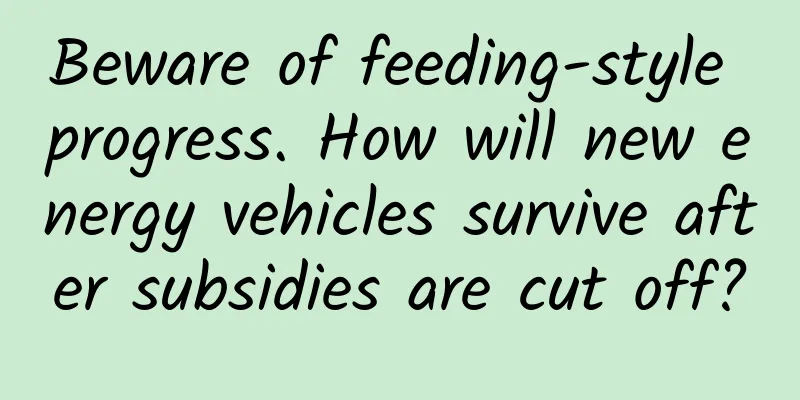Beware of feeding-style progress. How will new energy vehicles survive after subsidies are cut off?

|
China is "leading" the global new energy vehicle market. Data shows that in October this year, 49,000 new energy vehicles were produced and 44,000 were sold, up 14.3% and 8.1% year-on-year respectively. Among them, the production and sales of pure electric vehicles were 44,000 and 39,000 respectively, up 28.0% and 19.7% year-on-year respectively; from January to October, new energy vehicle sales were 337,000, up 82.2% over the same period last year. In Shanghai , the number of new energy vehicles promoted and applied has ranked first in the country for two consecutive years, and it has become the city with the largest number of new energy vehicles in the world . China's market performance in the first half of the year has surpassed the United States' annual sales of 180,000 and jumped to the first place in the world. At the same time, the position of the world's new energy vehicle company leader has also changed hands. BYD has surpassed Tesla , BMW and Nissan with an annual sales volume of 61,700 vehicles, which is really formidable. The strong numbers do not mean that our technology or market has really reached a level comparable to that of new energy vehicles in traditional automobile powerhouses. The beautiful numbers are that people are gradually opening up to new things, and car manufacturing technology has also made great progress. All national policies have contributed greatly. The continuous introduction of favorable policies such as exemption from purchase tax, unlimited driving and subsidies have driven the development of China's new energy vehicle industry. But what is even more peculiar is that we can basically only see electric vehicles in large and medium-sized cities, especially those cities with more subsidies. On the one hand, this highlights that there are still many insurmountable difficulties in electric vehicles that prevent them from being as popular as traditional vehicles. On the other hand, it has also created a unique policy market in the world. 1. Many players compete in the new energy vehicle market Driven by policies, the enthusiasm of various companies to produce new energy vehicles is also very high. In addition to BYD mentioned above, traditional old-brand car companies such as BAIC have risen one after another, and various emerging companies have also sprung up like mushrooms after rain, such as Internet cars and new material cars. Some of them are down-to-earth and dedicated to the country's automobile industry, but it is not ruled out that more are for a share of the subsidy cake. Each manufacturer also clearly swore its sovereignty, as if saying that whoever dares to touch my cake will be destroyed. Changan released the "2025 New Energy Development Strategy", by which time Changan will put 34 new energy vehicles into production; Geely Automobile also announced that by 2020, new energy vehicle sales will account for 90% of total sales. Overnight, all kinds of R&D centers were established, and many even opened abroad. Since China's electric vehicles are already leading the world, why should they open abroad? Self-contradictory gave himself a solid slap! 2. Beware of feeding-style progress Want to be popular? Subsidies are the fastest way. Internet companies such as Didi Taxi and Meituan.com have firmly grasped consumers after burning huge amounts of money. However, the two giants are not doing well at present. Spending money can make them popular but not necessarily survive. As for the current LeTV electric car, it is more like a vivid story in a PPT. Policies and subsidies should be updated in a timely manner while firing the first shot. The benefit of subsidies is government support, direction and funds. Those companies with ability but lack of funds will naturally see the dawn and cut through thorns for the dream of blue sky and white clouds. However, there are always smart companies that rely on "infusion" to survive, and even frantically "cheating subsidies", because many companies' annual profits are not even as fast and as much as a subsidy. The lack of supervision also exposes the dilemma of the survival of new energy vehicles, and companies are prone to extreme dependence on policy benefits. According to national policies, by 2020, subsidies for new energy will be completely cancelled, and will be replaced by a more market-oriented carbon emissions trading system and more stringent corporate fuel consumption limit management. This means that after 2020, the production of new energy will no longer be a profitable business. However, the core technology of independent car companies is weak at present, so the subsidy drive cannot stop, and the future should be a dual regulation of the market and policy. 3. Countermeasures Subsidies are not a golden rice bowl, and enterprises need to seek development from the market. Domestic brands have not yet entered the international forefront in terms of R&D strength and technical reserves in the field of new energy. In the future, we will raise the technical threshold and reduce the subsidy amount to maximize the support of subsidies for technology-based enterprises, rather than just building an office and moving two batteries to get subsidies. In the future, policy incentives will be used to replace pure money-burning subsidies, such as free parking, reduced charging fees, free recycling and replacement by car companies, full coverage of domestic infrastructure, etc. The incentive methods will be diversified and gradually withdrawn. The country will continue to play the role of market regulation, develop downstream industries and enhance the influence of new energy vehicles. For example, government service agencies will fully purchase new energy vehicles, which are widely used in public buses, on-duty operations, etc. Completing resource upgrades can also support new energy vehicles more personally. The result of optimization and improvement is to occupy the global market; encourage new energy vehicles to participate in the leasing and rental industry. The traditional automobile industry has failed to realize the dream of growing from big to strong, and has basically lost the opportunity to catch up with or even surpass developed countries. New energy vehicles, which have similar technology accumulation and starting time as foreign countries, shoulder the heavy responsibility of "overtaking on the curve". We must digest and promote foreign advanced technologies in a timely manner, and we cannot just buy a car, dismantle it, and then build a four-in-one. If so, we can only continue the traditional old path in the future. Although there are dozens of new energy vehicle brands on the market, which is quite a flourishing trend, there are no high-end core competitiveness. On the contrary, there are few foreign new energy vehicle brands, but there are countless car companies and Internet companies that are deeply cultivating. Unlike domestic car companies that "focus on production and neglect research and development", overseas car companies continue to accumulate technical advantages with their own funds and talents. They are not in a hurry to roll out the existing "semi-finished products" for production. What they like to see is that a certain company has developed technologies such as automatic driving and active safety. Once such technical advantages accumulate to a certain extent, it is enough to easily PK various so-called world-leading domestic car companies that are "eager for quick success and instant benefits". How should we deal with it at that time? Electric cars are different from traditional cars, but in terms of function, they are just a means of transportation. People choose things from a pragmatic perspective, that is, whether this thing is convenient for me to use and whether it will increase my cost of use. If electric cars are too troublesome to use and the supporting facilities are not complete, in this case, the enthusiasm for use will naturally not be high, and if the price remains high, many people may stay away. Therefore, we must start with reducing costs from tens of thousands of parts of the car, especially the energy storage part, which is currently the weakest but most challenging part; actively develop emerging materials to replace existing lithium batteries, such as graphene, fuel cells, titanium manganese alloys, etc. For a brand to survive for dozens or even hundreds of years, the most important thing is to adapt to the changes of the times, establish core brand values, and promote corporate culture. At present, there is still a long way to go. Of course, I still prefer to believe that the Chinese auto industry can "break through" and lead the world trend. As a winner of Toutiao's Qingyun Plan and Baijiahao's Bai+ Plan, the 2019 Baidu Digital Author of the Year, the Baijiahao's Most Popular Author in the Technology Field, the 2019 Sogou Technology and Culture Author, and the 2021 Baijiahao Quarterly Influential Creator, he has won many awards, including the 2013 Sohu Best Industry Media Person, the 2015 China New Media Entrepreneurship Competition Beijing Third Place, the 2015 Guangmang Experience Award, the 2015 China New Media Entrepreneurship Competition Finals Third Place, and the 2018 Baidu Dynamic Annual Powerful Celebrity. |
<<: Xiaomi wants to enter the high-end market? Configuration and novelty alone are not enough
>>: 3D printing technology can also make electric cars. The key is low cost.
Recommend
XGIMI Yang Rong: Soft marketing methods that do not harm user experience can create more benefits
On September 22, at the "2017 China OTT Larg...
New Audi A4L review: How does this entry-level luxury car, which has been hailed as a god car by car reviewers, perform?
As living standards continue to improve, people&#...
New nuclear weapons make 4K gaming a normal practice ASUS ROG STRIX GTX 1080 review
NVIDIA CEO Jensen Huang once announced at the GTX...
Getting started with information flow advertising, what are the dimensions that can be optimized?
With the explosive growth of mobile Internet , th...
How to develop the financial accounting applet in Zhongshan and how to make the financial diary applet?
With the economic downturn, many people have begu...
Xiaomi and LeTV are fighting each other? What caused it?
Editor’s Note: The Internet community has been in...
What does the skyrocketing price of KFC’s limited edition blind boxes tell us about our psychology?
Key Points ★ The “Pandora Effect” makes us flock ...
Imitation and gap: Are Google's series of hardware launches more hype than substance?
Recently, Google released a series of new hardwar...
10 community operation experiences gained in 365 days with RMB 150,000!
Real cases and diligent exploration of community o...
Tencent Information Stream and QQ Advertising Double 11 E-commerce Promotion Red Book
The annual Double Eleven promotion is approaching...
They stepped out of the circle of friends of China's aerospace industry with their own feet
In China Aerospace Science and Technology Corpora...
How much does it cost to find an African to record a blessing video? Where can I buy the video of black people shouting slogans?
What is the most fashionable way to send blessing...
They took the dry air guns away, leaving behind 52 steel arteries
In 2021, there were continuous important news abo...
Where is carbon dioxide placed? This time there are many new destinations!
Review expert: Gan Qiang, lecturer at Beijing Ins...
Information flow advertising | Double 11 is coming, take the 12 sets of e-commerce materials with the best conversion for free!
Double 11 is coming, and it’s time to spend money...









